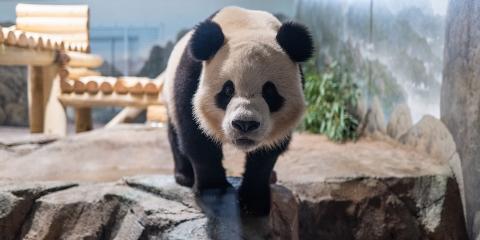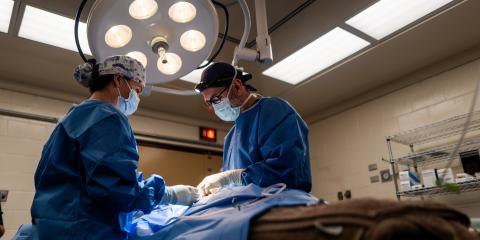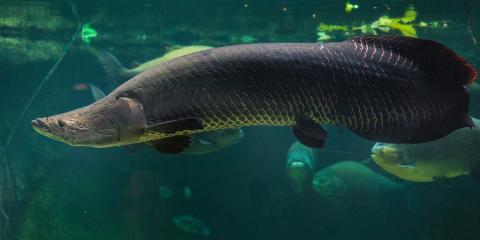Physical Description
Domestic cattle belong to the genus Bos and the species taurus and indicus. All British and European cattle breeds, such as Angus, Hereford, Holstein, Shorthorn and Simmental, belong to the taurus species. The humped cattle of tropical countries, such as Brahman and Africander, belong to the indicus species. They are also called Zebu or "eared" breeds.
An individual may be referred to as a bull, cow, heifer, steer or calf. These terms refer to an animal's sex, age and reproductive status. Calves are cattle of either sex that are 1 year old or younger. Bulls are intact male cattle of any age, while the term steer refers to castrated male cattle. A heifer is a female that has not yet had a calf, and a cow is a female that has had at least one calf. In most species, the bull is much larger than the cow. Breeds can be polled (genetically hornless) or horned. Both male and female wild cattle species have horns, and the bull's horns are larger and thicker than the cow's.
Unlike humans, cattle have panoramic vision, which means they can see almost all the way around themselves without moving their heads. Their depth perception, however, is only focused in a small forward view. This means that, while a cow might be able to see you standing at its side, it cannot necessarily judge how close or far away you actually are. This may explain why a cow can be startled when approached, even if you have been in its field of vision for some time.
There are three types of cattle:
- Dual-purpose cattle are breeds selected for both meat and milk production. They include the Milking Shorthorn, Red Dane, Red Polled, Dexter and Pinzgauer. These cattle are typically smaller than most beef breeds and produce less milk than most dairy breeds.
- Beef cattle have been bred and selected primarily for the production of meat, and many breeds have been developed or adapted for special conditions. There are more than 60 breeds of beef cattle in North America. Angus, Hereford and Polled Herefords are the most common. Beef cattle differ physically from dairy cattle; they have broader, heavier set bodies with shorter necks and legs.
- Dairy cattle are breeds that have been developed primarily to produce milk. North America's major breeds of dairy cattle include the Holstein-Friesian, Guernsey, Jersey, Ayrshire, Brown Swiss and Milking Shorthorn. The Holstein-Friesian is the largest breed and produces the greatest volume of milk. In 2008, the average dairy cow in the U.S. produced about 20,461 pounds of milk. Individual cows may produce several times this average amount. Dairy cows typically produce milk for five or six years, but some continue to produce milk until the age of 20 or older. Dairy cows only develop an udder and produce milk after becoming pregnant.
Native Habitat
Modern domestic cattle evolved from a single, early ancestor—the auroch. It is believed that the last auroch was killed in Poland in 1627. Early cattle provided meat, milk and labor to their owners. In many cultures, cattle have spiritual, economic or political importance far beyond the monetary value of the animals themselves.
Food/Eating Habits
Cattle are ruminants; their complex, four-compartment stomach enables them to digest and convert plant material into energy and important “building blocks” of the body. They eat hay, corn, soybeans, grass, wheat and silage (fermented feed). They can make use of low-quality or nonproductive rangeland, but must be properly managed to avoid causing damage to the environment.
These herbivores' diet typically consists of hay or roughage (80 to 90 percent of total dry matter), commercial feed that includes grain, vitamins and minerals, and water. Proper feeding of cattle can be complicated and requires a combination of scientific knowledge, creativity and good management. The amount and type of feed that a single cow, calf or bull is fed depends on how much he or she weighs, how old he or she is, how much milk a cow gives and where she is in her gestation cycle. Cattle spend approximately six hours a day grazing and another eight hours ruminating.
Social Structure
Domestic cattle are social animals and live in groups called herds.
Reproduction and Development
Females reach sexual maturity when they are about 1 year old and typically have their first calf around age 2. Breeding can continue until a female is about 12 years old and can occur year-round. Estrus (heat) is the period of time when a cow or heifer is sexually receptive and signals that an egg is about to be released. It normally occurs every 18 to 24 days. The average time that a female is in standing heat is about 12 to 18 hours. A female in standing heat allows males to mount her as she stands. Ovulation follows standing heat. Breeding can be natural or through artificial insemination.
Usually, one calf is born after nine months of gestation. Labor typically lasts two to four hours, with the calf emerging front feet first with its head tucked between its legs. A cow may occasionally have twins. If the twins consist of a male (bull) and female (heifer), the heifer calf is usually infertile (called a freemartin heifer). Infertility in freemartin heifers occurs due to a transfer of hormones or cells from the developing male calf, causing the female's reproductive tract to be underdeveloped.
Calves are precocial, meaning they are able to stand and walk within an hour after birth. A calf needs to drink milk within the first few hours following its birth. This special milk is called colostrum and contains antibodies that help the calf fight off disease and stay healthy. Cows produce colostrum for the first 72 hours after giving birth to a calf. Calves are weaned when they are about 6 to 7 months old.
Help this Species
- Consider going meat-free one day each week to help reduce the demand on the livestock industry and decrease your carbon footprint!
Meet the Animals
Kids’ Farm is home to a Hereford calf named Willow and a Holstein calf named Magnolia. Magnolia is black and white with black speckles on her nose. Willow is the youngest cow at Kids' Farm. She is red and white with a red spot above her nose.


